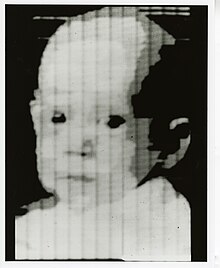Digital image
A digital image is an
Raster
Raster images have a finite set of digital values, called picture elements or pixels. The digital image contains a fixed number of rows and columns of pixels. Pixels are the smallest individual element in an image, holding quantized values that represent the brightness of a given color at any specific point.
Typically, the pixels are stored in computer memory as a raster image or raster map, a two-dimensional array of small integers. These values are often transmitted or stored in a compressed form.
Raster images can be created by a variety of input devices and techniques, such as digital cameras, scanners, coordinate-measuring machines, seismographic profiling, airborne radar, and more. They can also be synthesized from arbitrary non-image data, such as mathematical functions or three-dimensional geometric models; the latter being a major sub-area of computer graphics. The field of digital image processing is the study of algorithms for their transformation.
Raster file formats
Most users come into contact with raster images through digital cameras, which use any of several
Some
Vector
Often, both raster and vector elements will be combined in one image; for example, in the case of a billboard with text (vector) and photographs (raster).
Example of vector file types are
Image viewing
Image viewer software displayed on images.
Some scientific images can be very large (for instance, the 46 gigapixel size image of the Milky Way, about 194 Gb in size).[11] Such images are difficult to download and are usually browsed online through more complex web interfaces.
Some viewers offer a
History


Early
Rapid advances in
The invention of computerized axial tomography (
Advances in microprocessor technology paved the way for the development and marketing of
Digital image sensors
The first semiconductor image sensor was the CCD, developed by
Early CCD sensors suffered from
The
Digital image compression
An important development in digital
Mosaic
In digital imaging, a mosaic is a combination of non-overlapping images, arranged in some tessellation. Gigapixel images are an example of such digital image mosaics. Satellite imagery are often mosaicked to cover Earth regions.
Interactive viewing is provided by
See also
- Computer printer
- DICOM
- Digital art
- Digital geometry
- Digital image correlation
- Digital image editing
- Digital image processing
- Digital photography
- Geocoded photo
- Optical character recognition
- Scanography
- Signal processing
References
- OCLC 966609831.
- ^ Digital Negative (DNG) Specification Archived 2011-04-20 at the Wayback Machine. San Jose: Adobe, 2005. Vers. 1.1.0.0. p. 9. Accessed on October 10, 2007.
- ^ universal photographic digital imaging guidelines (UPDIG): File formats - the raw file issue Archived 2011-10-20 at the Wayback Machine
- ^ Archaeology Data Service / Digital Antiquity: Guides to Good Practice - Section 3 Archiving Raster Images - File Formats Archived 2011-12-14 at the Wayback Machine
- ^ University of Connecticut: "Raw as Archival Still Image Format: A Consideration" by Michael J. Bennett and F. Barry Wheeler Archived 2011-09-14 at the Wayback Machine
- ^ Inter-University Consortium for Political and Social Research: Obsolescence - File Formats and Software Archived 2011-11-02 at the Wayback Machine
- ^ JISC Digital Media - Still Images: Choosing a File Format for Digital Still Images - File formats for master archive Archived 2011-11-16 at the Wayback Machine
- ^ The J. Paul Getty Museum - Department of Photographs: Rapid Capture Backlog Project - Presentation Archived 2012-06-10 at the Wayback Machine
- ^ most important image on the internet - Electronic Media Group: Digital Image File Formats Archived 2010-12-14 at the Wayback Machine
- ^ Archives Association of British Columbia: Acquisition and Preservation Strategies (Rosaleen Hill)
- ^ "This 46-Gigapixel photo of the Milky Way will blow your mind". 23 October 2015. Archived from the original on 5 July 2018. Retrieved 5 July 2018.
- ^ Fiftieth Anniversary of First Digital Image Archived 2010-10-14 at the Wayback Machine.
- ^ Azriel Rosenfeld, Picture Processing by Computer, New York: Academic Press, 1969
- ^
Gonzalez, Rafael, C; Woods, Richard E (2008). Digital Image Processing, 3rd Edition. Pearson Prentice Hall. p. 577. ISBN 978-0-13-168728-8.)
{{cite book}}: CS1 maint: multiple names: authors list (link - ^
Jähne, Bernd (1993). Spatio-temporal image processing, Theory and Scientific Applications. Springer Verlag. p. 208. ISBN 3-540-57418-2.
- ISBN 978-0-8194-3698-6. Archivedfrom the original on 2020-11-15. Retrieved 2020-06-06.
- ISBN 978-3-319-49088-5. Archivedfrom the original on 2020-11-15. Retrieved 2019-10-10.
- .
- ^ .
- ^ U.S. Patent 4,484,210: Solid-state imaging device having a reduced image lag
- S2CID 10556755.
- S2CID 18831792.
- S2CID 108450116.
- ^ "CMOS Image Sensor Sales Stay on Record-Breaking Pace". IC Insights. May 8, 2018. Archived from the original on 21 June 2019. Retrieved 6 October 2019.
- from the original on 2016-06-10. Retrieved 2019-09-14.
- CCITT. September 1992. Archived(PDF) from the original on 30 December 2019. Retrieved 12 July 2019.
- BT.com. BT Group. 31 May 2018. Archived from the originalon 5 August 2019. Retrieved 5 August 2019.
